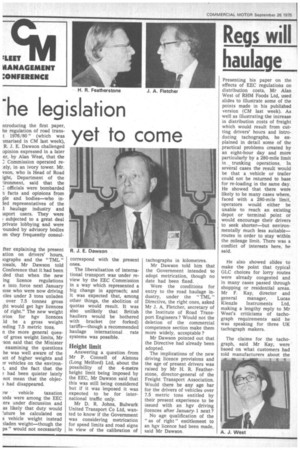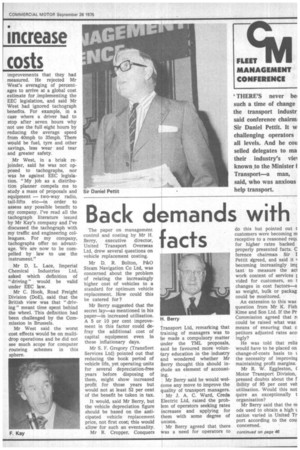Regs will haulage increase costs
Page 46

Page 47

If you've noticed an error in this article please click here to report it so we can fix it.
Presenting his paper on the effects of EEC regulations on distribution costs, Mr Alan West of RHM Foods Ltd, used slides to illustrate some of the points made in his published version (CM last week). As well as illustrating the increase in distribution costs of freight which would result from cutting drivers' hours and introducing tachographs, he explained in detail some of the practical problems created by an eight-hour day and more particularly by a 280-mile limit in trunking operations. In several cases the result would be that a vehicle or trailer could not be returned to base for re-loading in the same day. He showed that there were likely to be many cases where, faced with a 280-mile limit, operators would either be unable to reach an existing depot or terminal point or would encourage their drivers to seek shorter—but environmentally much less suitable— routes in order to stay within the mileage limit. There was a conflict of interests here, he said.
He also showed slides to make the point •that typical GLC choices for lorry routes were already congested and in many cases passed through shopping or residential areas. Mr F. Kay, director and general manager, Lucas Kienzle Instruments Ltd, making a lengthy reply to Mr West's criticisms of tachograph requirements said he was speaking for three UK tachograph makers.
The claims for the tachograph, said Mr Kay, were • based on what customers had told manufacturers about the improvements that they had measured. He rejected Mr West's averaging of percentages to arrive at a global cost estimate for implementing the EEC legislation, and said Mr West had ignored tachograph benefits. For example, in a case where a driver had to stop after seven hours why not use the full eight hours by reducing the average speed from 40mph to 35mph. There would be fuel, tyre and other savings, less wear and tear and greater safety.
Mr West, in a brisk rejoinder, said he was not opposed to tachographs, nor was he against EEC legislation. "My job as a distribution planner compels me to study a mass of proposals and equipment — two-way radio, tail-lifts etc—in order to assess any possible benefit to my company. I've read all the tachograph literature issued by Mr Kay's company and I've discussed the tachograph with my traffic and engineering colleagues. For my company, tachographs offer no advantage. We are now to be compelled by law to use the Instrument."
Mr D. L. Lace, Imperial Chemical Industries Ltd, asked which definition of "driving" would be valid under EEC law.
Mr C. Hook, Road Freight Division (DOE), said that the British view was that " driving " meant time spent behind the wheel. This definition had been challenged by the Commission in Brussels.
Mr West said the worst cost effects would be on multidrop operations and he did not see much scope for computer routeing schemes in this sphere.




































































































